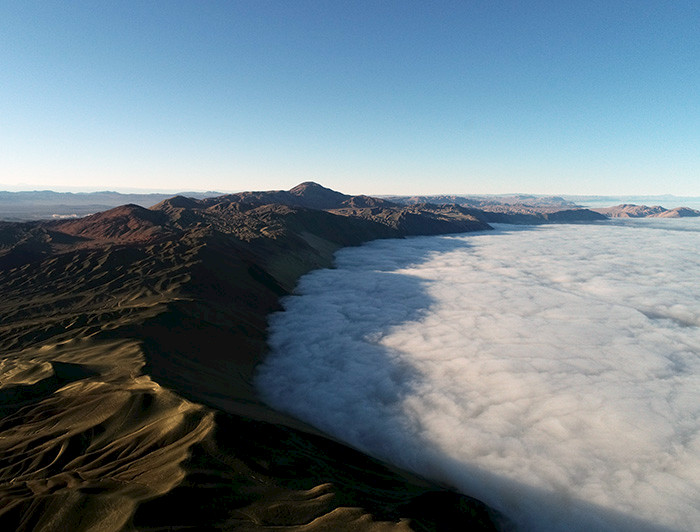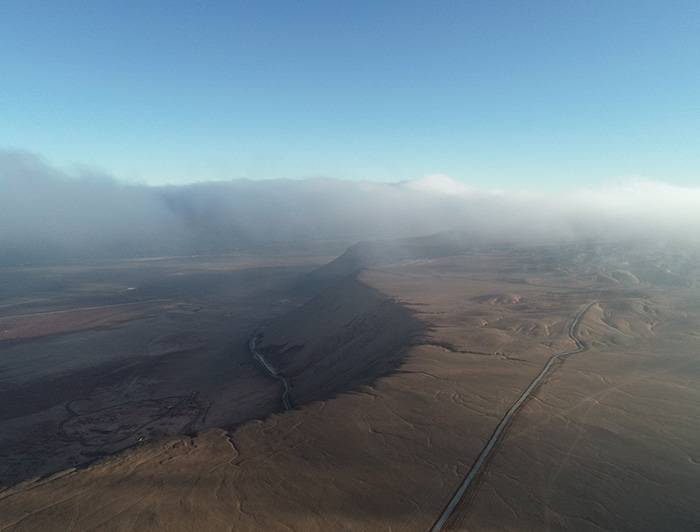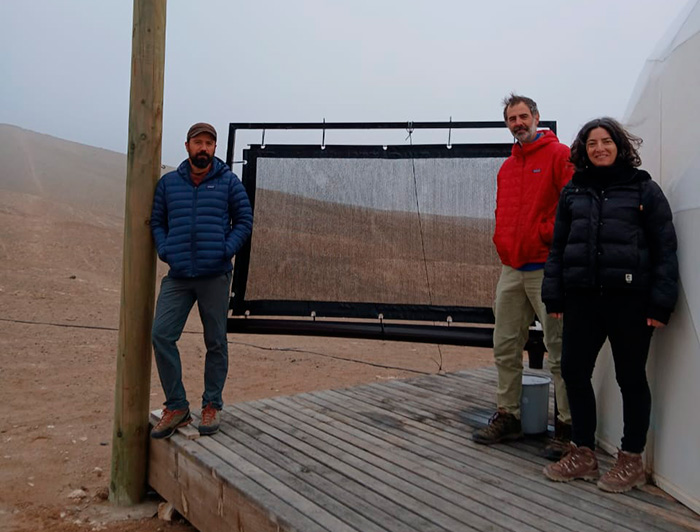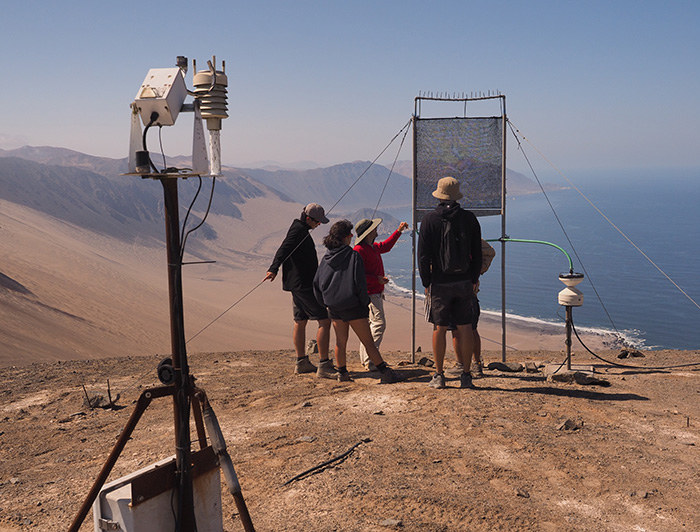National Geographic Society recognizes project that explores Fog as a source of fresh water
21 de Octubre, 2024
More than 200 proposals from around the world, seeking to protect freshwater resources in areas of water scarcity, were submitted to the “Freshwater Conservation Projects” competition. Only four were awarded, and one of them is Chilean. This is the research led by the UC Atacama Desert Center (CDA UC), which will evaluate the potential of fog as a source of fresh water, working together with local communities.

photo_camera The CDA UC proposal involves evaluating the potential of fog as a source of fresh water and working with local communities, in a fog water project in the Atacama Desert along the northern coast of Chile. (Photo credit: Felipe Lobos)
Water scarcity is one of the most pressing challenges facing the world today. With over 2 billion people living in water-stressed countries, the freshwater crisis profoundly impacts agriculture, health, and sustainable development. As climate change exacerbates this situation, finding innovative and sustainable solutions for efficient water resource management is crucial.
Chile is grappling with a significant water crisis, as the availability of fresh water becomes increasingly limited due to climate change, declining rainfall, and resource overexploitation, among other factors. In this context, a research team from the UC Atacama Desert Center (CDA UC) has been selected by the National Geographic Society in its global "Freshwater Conservation Projects" competition. Their project is the sole Chilean initiative among the four selected from 200 proposals worldwide.
The competition supports community-based freshwater conservation projects in critical water-scarce regions and is part of the Global Freshwater Initiative. Launched in 2023 at the United Nations Water Conference, this initiative aims to address the global freshwater scarcity crisis and foster sustainable actions. Each selected project will receive up to $50,000 in funding to implement their proposed solutions.
The CDA UC's proposal focuses on assessing the potential of fog as a fresh water source and collaborating with local communities on a fog-water project in the Atacama Desert along Chile's northern coast. The project stands out not only for its scientific rigor but also for its potential impact on ecosystem conservation and sustainable water management.
"As a university, we take great pride in seeing this type of project receive international recognition," says UC Vice Rector for Research, Pedro Bouchon. "It exemplifies how academic research can directly benefit communities and territories, particularly in addressing such a vital issue as the water crisis and the need to generate clean water sources in arid areas. I also congratulate the UC Atacama Desert Center team for their selection in such a highly competitive global fund as the one offered by the National Geographic Society."
The other initiatives awarded are:
-Community-led restoration of abandoned rice fields to convert them into a natural wetland and forest habitat to improve groundwater recharge and freshwater biodiversity in the Notori River Basin in Japan.
-Working with a local farming community to integrate the Internet of Things with an indigenous nature-based solution to conserve and equitably distribute water on the island of Java, Indonesia.
-Collaborating with local groups interested in establishing conservation and rehabilitation zones for wetlands in the Asi-Orontes River Delta to improve water quality following the 2023 earthquake near the Turkey-Syria border.
A Fog Map

photo_camera The CDA UC Fog Monitoring Network allows us to assess how fog patterns change over time and space across a wide range of latitudes and diverse ecosystems. (Photo credit: Felipe Lobos)
The project recognized by the National Geographic Society is led by Virginia Carter, researcher at the UC Atacama Desert Center and academic at the Universidad Mayor, and Camilo del Río, professor at the UC Institute of Geography and director of the same center. With more than 20 years of experience in fog studies, they have dedicated much of their careers to understanding this phenomenon and its relationship with climate change.
"My approach to the fog issue has always been from a climatic perspective," explains Camilo del Río, PhD in Natural Sciences (Dr. rer. nat.) from the University of Heidelberg, Germany, and Master in Geography and Geomatics from the Pontificia Universidad Católica de Chile. One of his main interests is to understand how changes in the presence and formation of the stratocumulus cloud, which gives rise to fog, could be related to changes in ecosystems and the potential use of this phenomenon as a water resource.
"The fog cloud, which for years has been a constant presence on the desert coasts, represents a possible solution to the water crisis, but its behavior is uncertain. What happens if we build a fog-water collection system and the cloud disappears the following year?" the professor wonders.
To answer this question, Professor del Río's team has led the construction of a Fog Monitoring Network, allowing the CDA UC to evaluate how fog varies over time and space across a large latitudinal range and in different ecosystems. Initially, fog had been studied mainly in the hyper-arid and arid zones of the national territory. However, with the megadrought affecting central Chile, the researcher expanded his focus to a region where fog had historically not been a research focus: central Chile.
"Fog has always been present in central Chile, but it hadn't been the focus of our research. The megadrought and the need for water resources brought this issue to the forefront," he adds.
The network currently has 25 stations, thanks to resources obtained through grant applications, which have allowed the center to deepen its studies on fog and its variability. "We have made various efforts to maintain and extend this network, and we are very happy to have been awarded the project with the National Geographic Society, which will allow us to expand the network and give us global visibility," says Camilo del Río, adding: "Thanks to this support, we will be able to share our progress with the world and contribute to the knowledge of water resources and biodiversity conservation."
Virginia Carter has extensive experience in implementing fog-water collection projects, allowing it to be transformed into a usable resource in areas with water scarcity. "I started building fog catchers when I was about 21 years old, and today I can proudly say that I am one of the few women in the world who has built these systems in different places like Guatemala, rural areas of Africa, and Chile," says the researcher, trained at the UC Institute of Geography. Over the years, she has worked in various regions of the world, bringing her knowledge and experience to rural communities where access to fresh water is limited.

photo_camera From right to left: Atacama Desert UC Center researchers Virginia Carter, Camilo del Río, and Felipe Lobos. (Fotografía gentileza de CDA UC)
Virginia Carter, who holds a PhD in Geography from the University of Ghent, Belgium (PhD in Sciences), is currently the Field Project Coordinator at the NGO FogQuest. In this role, she has worked closely with rural communities in developing countries, promoting their active participation in fog water collection and resource management. She also leads community engagement efforts, with a particular focus on empowering women in various localities in northern Chile through her work with the UC Atacama Desert Center.
Her research has centered on exploring ways to integrate this type of solution into public policies for water planning and management, with the understanding that science must play a crucial role in decision-making to mitigate the impacts of climate change in the most vulnerable communities. Her goal is not only to generate knowledge but also to influence water management policies, making science accessible to communities and contributing to improving the lives of those facing water scarcity.
Currently, she co-directs the Fog Water Map Project, which aims to develop a public platform providing detailed information on fog water availability in seven regions of Chile, from Arica to Maule. This tool is expected to be a key resource for water management decisions and a valuable asset in advancing scientific research.
Additionally, the map is expected to play a fundamental role in improving water resource governance and addressing water security challenges, especially in the context of climate change adaptation efforts.
A Project with Global Reach

photo_camera Fog catchers capture water droplets from the mist known locally as camanchaca. The droplets trickle down through the mesh into PVC pipes, which channel the water into collection drums. This innovative system harvests a valuable water resource from the air. (Photo credit: Nicole Saffie)
The initiative financed by the National Geographic Society will be developed between November 2024 and May 2026, with the goal of consolidating the Fog Water Monitoring Network managed by the center and promoting its use as a complementary water resource in areas with water scarcity.
Along Chile’s northern and central coast, the project will evaluate the potential of fog as a source of fresh water and its impact on ecosystem conservation. Through an extended network, the CDA UC seeks to better understand this phenomenon and its viability as a sustainable resource, especially in the context of an increasing water crisis.
In a scenario where traditional water sources such as rivers and reservoirs are increasingly depleted, fog emerges as a potential alternative that could relieve pressure on these resources. The arid regions of northern and central Chile are a clear example of this urgent need, and the center’s project fits within this global search for alternatives to ensure access to water in vulnerable areas.
The research on how to capture and use fog water could not only change the local water reality but also offer a replicable approach in other areas of the world facing similar situations.
The National Geographic Society selected this project as one of the four globally funded within its freshwater conservation program. Receiving more than 200 proposals from around the world, the CDA’s application was highly competitive and turned out to be the only one from Chile to reach the final stage. The project was valued for its innovative approach and the robust Fog Monitoring Network that the UC Atacama Desert Center has been developing, as well as for its commitment to community participation and knowledge transfer.
One of the keys to this initiative is the collaboration with local communities. In a context where technological solutions alone are not sufficient, the researchers at the CDA UC understand that the success of a fog-water collection project largely depends on the integration of communities into the process. The collaboration with these communities not only aims at adopting the technology but also at strengthening local capacity to manage this resource comprehensively.
Professor Virginia Carter emphasized the importance of using a platform as influential as the National Geographic Society to disseminate research and knowledge generated towards two key sectors: the communities that could benefit from it and the decision-makers. This seeks to facilitate the inclusion of fog-water in territorial and water policies and strategies.
Expanding the Study of Fog

photo_cameraThe fog gauge, also known as a standard fog collector, is the instrument used to measure the potential for harvesting water from fog. (Photo credit: Nicole Saffie)
The research team also includes Felipe Lobos, professor at the Faculty of Agronomy and Natural Systems and researcher at the CDA UC, who has developed the meteorological model underpinning the Fog Water Map, a key tool for identifying the most suitable areas for collecting this resource. Additionally, Marcos Zegers, a photographer focused on the relationship between humans and the territory, and Orlando Rojas, president of the Atacama Fog Catchers Association, are part of the project.
In this context, Felipe Lobos outlined several specific objectives of the project, including strengthening the fog monitoring network by adding two stations in locations where fog water is already used for crops, but where no current measurements exist. They also aim to determine the exact volumes of water that can be collected in areas like Falda Verde in the Chañaral commune of the Atacama Region, where vegetables are grown with fog water. Furthermore, they intend to gather information about fog collection in Paposo in the Antofagasta Region, a little-explored ecosystem with high biodiversity.
This initiative not only promises to strengthen knowledge about this vital resource but also to inspire concrete actions for the conservation of freshwater in the context of the growing global water scarcity crisis.
With this award, the CDA UC consolidates itself as a leader in fog-water research both nationally and internationally. It is expected that the Fog Monitoring Network and the Fog Water Map will gain significant visibility in the World Water Map by the National Geographic Society, a fundamental resource to help people worldwide understand the water scarcity issues exacerbated by factors such as climate change, increased consumption, and economic development.